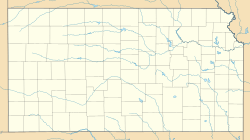John Brown Museum (Osawatomie, Kansas) facts for kids
Quick facts for kids |
|
|
John Brown Cabin
|
|
 |
|
| Location | John Brown Memorial Park, Osawatomie, Kansas |
|---|---|
| Area | less than one acre |
| Built | 1855 |
| NRHP reference No. | 71000319 |
| Added to NRHP | March 24, 1971 |
The John Brown Museum is also known as the John Brown Museum State Historic Site and the John Brown Cabin. It is located in Osawatomie, Kansas. The Kansas Historical Society manages this important historical place.
The site includes a log cabin that belonged to Reverend Samuel Adair and his wife, Florella. Florella was the half-sister of John Brown, a famous leader who fought against slavery. John Brown lived in this cabin for about 20 months while he was in Kansas. He planned many of his activities against slavery from this very spot.
Today, the museum shows visitors what life was like back then. It tells the stories of John Brown, the Adair family, and other local people who worked to end slavery. You can see the original cabin, furniture, and items that belonged to the Adair family. There are also artifacts from the American Civil War.
Contents
The Story of the Cabin
When Kansas Territory was created in 1854, newspapers in the northern states encouraged people to move there. They wanted to make sure Kansas would become a "free state," meaning slavery would not be allowed. This land also offered a chance for families to start new lives. They could farm the rich land, enjoy the quiet countryside, and help protect the territory from slavery.
The Adair Family's Journey
Samuel and Florella Brown Adair had this dream. Florella's father, Owen Brown, was also the father of John Brown. Owen was a very strict religious man. He was a leader at Oberlin College. John Brown's mother died in 1808. Owen then married Sally Root, and Florella was one of their children.
Both Samuel and Florella went to Oberlin in Ohio. This college was special because it allowed both men and women, and people of all races, to study together. Samuel finished his studies to become a minister. After they married, they moved west. Samuel hoped to find a job in Osawatomie, Kansas Territory.
John Brown's Arrival
Five of John Brown's sons moved to Kansas after the Adairs. They faced many challenges, including sickness and the conflicts of Bleeding Kansas. "Bleeding Kansas" was a time when people who supported slavery and people who opposed it fought violently in the territory.
John Brown came to Kansas to help his sons. He didn't plan to stay forever. But in Kansas, he found people who shared his strong beliefs against slavery. These abolitionists fought against the government, which supported slavery. They often had conflicts with people from Missouri who came into Kansas to push for slavery.
Osawatomie, which was close to the Missouri border, was attacked and burned by pro-slavery groups on August 30, 1856. The Adair Cabin, which the family had bought in 1854 for about $200, survived the attack.
Life in the Territory
The Adair family faced many difficulties in Kansas. Reverend Adair worked hard to build his church. It was the first church in Osawatomie and the third Congregational church in Kansas. He provided the wood and stone for the church building. It was officially opened on July 14, 1861, and still stands today.
Florella also had a very tough life. Living in a log cabin was a big change for a college-educated woman. She had to learn to live without many things she was used to.
During the American Civil War, Samuel went to Fort Leavenworth to serve as a chaplain for soldiers. Florella took over his duties at home. She eventually became sick and joined Samuel in Leavenworth. She passed away in 1865.
After Florella's death, Samuel returned to Osawatomie. He helped start the first mental hospital in Kansas, which is now called Osawatomie State Hospital. He volunteered there as a chaplain for 11 years. Samuel died in 1898. He left the cabin to his son, Charles Storrs Adair.
About the Adair Cabin
The Adairs' home was a typical, simple log cabin for the frontier. Its fireplace was used for both warmth and cooking. People believe that a room in the back of the cabin was used to hide enslaved people who were escaping to freedom.
John Brown's son, Frederick, died nearby. He was the first person to die in the Battle of Osawatomie. Because of his actions in this area, John Brown became known as "Old Osawatomie Brown." Brown stayed in the cabin with the Adairs from time to time.
In 1911, the Kansas government named the battleground area John Brown Memorial Park. They also moved the cabin to its current spot in the park. The stone building that now surrounds and protects the cabin was built in 1928. In 1963, the Kansas Historical Society took over managing the site.
John Brown Statue
A statue of John Brown was added to the park in 1935. It was created by an artist named George Fite Waters. The Women's Relief Corps, a group from Kansas, helped pay for the statue.
See also
- John Brown Farm State Historic Site, in upstate New York
- John Brown Farm, Tannery & Museum, in Pennsylvania





